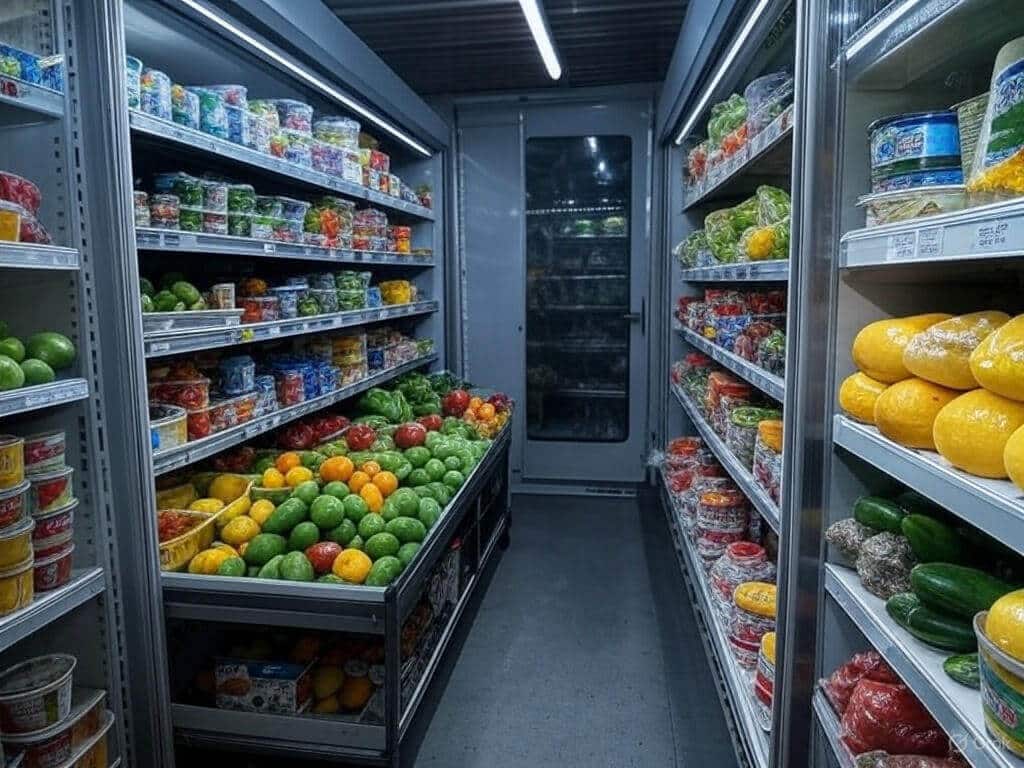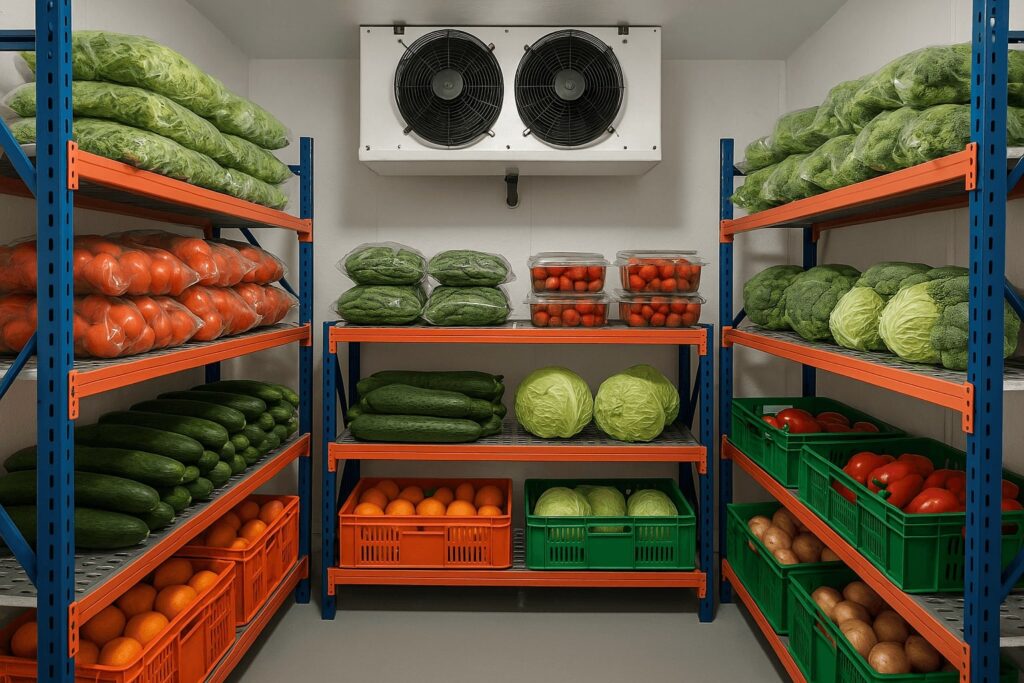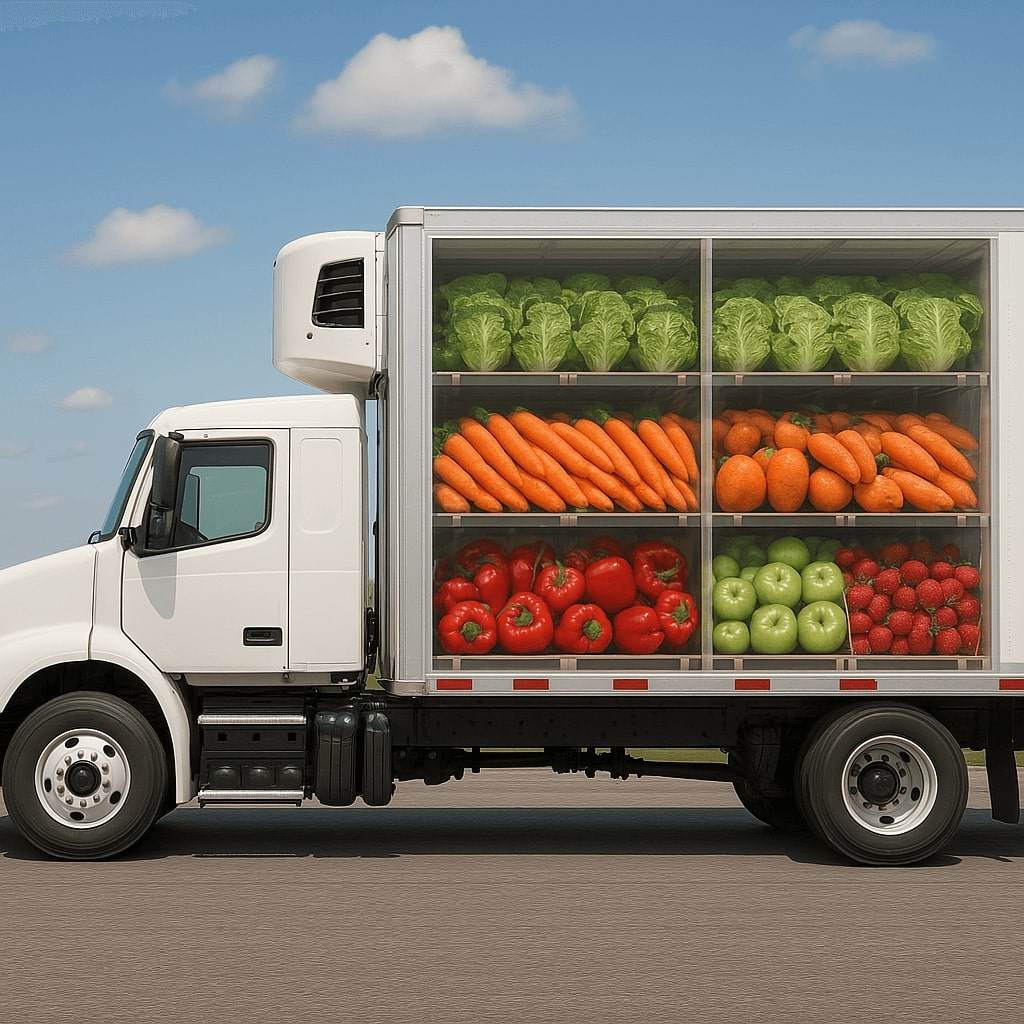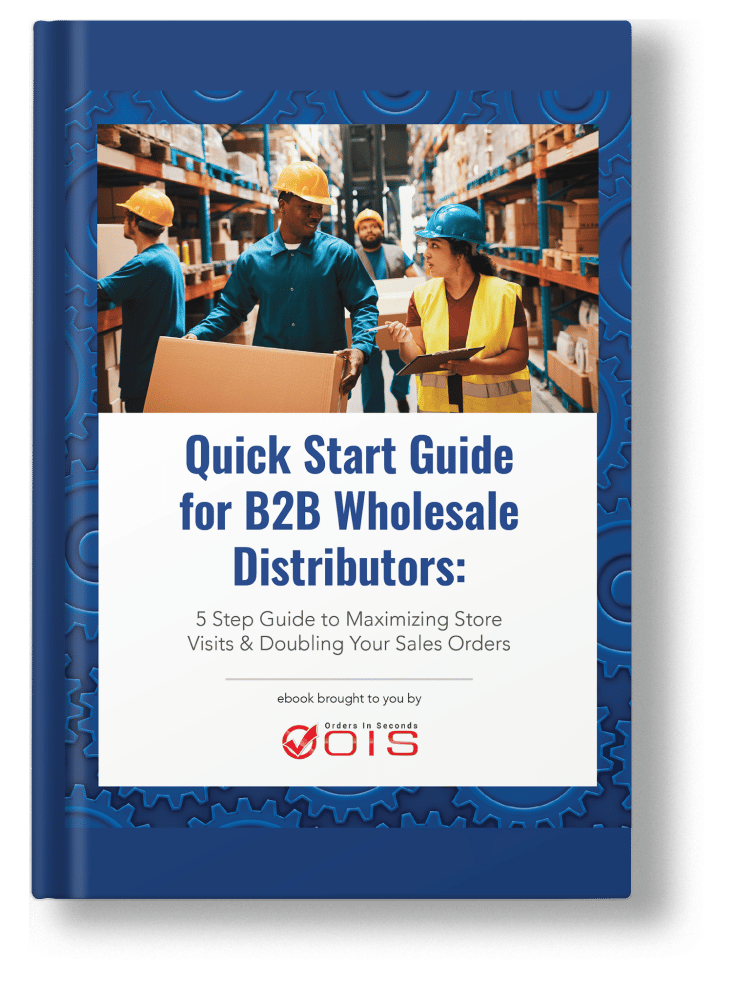Perishable goods, like fresh food and certain pharmaceuticals, spoil quickly without the right storage and transport. This article explains what perishable goods are and how to keep them fresh and safe.
Key Takeaways
- Proper storage and transportation of perishable goods requires strict temperature and humidity control to maintain quality and safety.
- Implementing advanced storage systems like Movirack and automated pallet shuttles can significantly enhance space utilization and operational efficiency for perishable goods.
- Digital traceability tools are essential for managing expiration dates and inventory for perishable items, ensuring compliance with safety standards and reducing waste.
Understanding Perishable Goods
Table of Contents
- Understanding Perishable Goods
- Storage Systems for Perishable Goods
- Best Practices for Managing Perishable Goods
- Transportation of Perishable Goods
- Advanced Solutions for Perishable Goods Management
- Case Studies
- Summary
- Frequently Asked Questions
- Enhance Your Product Traceability with Smarter Solutions

Perishable goods are items that spoil, decay, or become unsafe if not refrigerated below 40°F or frozen below 0°F. Unlike non-perishable goods, which have a long shelf life and can be stored at room temperature without risk of spoilage, perishable goods require stringent storage conditions. These goods include a wide range of products such as fresh fruits, vegetables, dairy, meat, and certain pharmaceuticals. Unlike non-perishable foods that can last for months, semi perishable foods have a short shelf life and require special handling to maintain their quality and safety.
Managing perishable goods effectively involves understanding their unique characteristics and implementing appropriate storage and transportation practices. Businesses must ensure guaranteed safe storage and traceability across the supply chain to prevent deterioration, spoilage, or impairment over time.
Failure to properly store perishable goods can lead to significant losses, both financially and in terms of customer trust.
The primary characteristics of perishable goods revolve around their sensitivity to temperature and humidity. These goods typically require refrigeration at 40°F (4°C) to slow down spoilage and freezing at 0°F (17°C) to halt bacterial growth completely. Controlling humidity is equally important as it helps preserve the integrity of perishable goods.
Pathogenic bacteria like E. coli, Salmonella, and Listeria are common concerns that can cause foodborne illness if perishable foods are not stored correctly. There are two types of bacteria that grow on perishables: pathogenic bacteria, which can cause illness, and spoilage bacteria, which lead to food deterioration.
Items such as live seafood, certain animals, plants, and fresh-cut flowers also fall under the category of perishable goods and require careful handling to remain fresh during transport.
Common examples of perishable goods in logistics include:
Meat
Dairy
Seafood
Frozen fruits
Vegetables
Certain chemical materials
During transportation, items like meat, fish, and seafood require careful handling to avoid spoilage. For instance, Danone’s Nutricia division specializes in children’s and medical nutrition products, showcasing the importance of proper logistics for sensitive perishable goods.
These logistics characteristics of perishable goods present a major challenge for companies, as maintaining the quality and safety of these products throughout the supply chain from production to consumption is critical.
Storage Systems for Perishable Goods

Selecting the right storage system for perishable goods storage systems is crucial to prevent spoilage and ensure safety. Controlling atmospheric pressure along with temperature and humidity is essential to prevent spoilage. Factors to consider include temperature control, weight, type, packaging, and regulatory standards such as the Food Hygiene Regulations 2006 and HACCP framework.
Different storage systems and examples like cold stores, Movirack mobile pallet racking, and automated pallet shuttle systems offer various benefits in terms of space utilization and operational efficiency. Successful implementations of these storage solutions illustrate enhanced efficiency and safety, emphasizing the importance of effective management practices.
Cold stores are essential for maintaining the freshness of perishable items during short-term storage, preventing spoilage by keeping products at optimal temperatures. These facilities are designed to prolong the freshness of perishable items by maintaining consistent, low temperatures.
Freezing chambers store products below 0º for long-term storage, effectively halting bacterial growth and spoilage over extended periods. This method is particularly useful for items like frozen precooked French fries, which require stable, low temperatures to maintain quality until they reach the consumer.
The Movirack mobile pallet racking system enhances efficiency by allowing the lateral movement of racking, which reduces the need for permanent aisles and maximizes storage space. Mooijer-Volendam B.V. employs Movirack technology to significantly optimize their storage space, allowing for rapid access to stored pallets and improving handling efficiency.
This system has enabled Mooijer-Volendam to store more than 4,300 pallets containing perishable goods, demonstrating the effectiveness of Movirack in enhancing order preparation and space utilization.
Automated pallet shuttle systems are designed to increase storage capacity and improve efficiency in warehouses handling high-turnover perishable goods. These semi-automated systems allow for improved storage density and operational efficiency by enabling higher inflows and outflows of perishable items. Nestlé utilizes a semi-automated Pallet Shuttle system to efficiently store and manage their powdered milk and other perishable products, enhancing their storage capacity and operational efficiency.
Nestlé’s use of a pallet shuttle system has enhanced their storage density and facilitated the rapid movement of pallets, which is critical for managing high turnover rates of perishable products.
Best Practices for Managing Perishable Goods
Maintaining proper environmental conditions is essential for preserving the quality of perishable products. Best practices for managing perishable goods include controlling temperature and humidity, adhering to strict hygiene standards, and ensuring traceability and monitoring expiration dates.
Implementing these strategies can significantly reduce losses from spoilage and ensure the freshness of perishable food before it reaches the consumer.
Temperature control is crucial for perishable goods as it prevents bacterial growth and ensures safety. Maintaining consistent temperature and humidity levels in storage areas is essential to prevent spoilage and extend the shelf life of perishable products.
Advanced monitoring systems, including IoT technology, enable real-time tracking of environmental conditions, ensuring that perishable goods remain within safe temperature ranges. Regular temperature checks are vital to maintain optimal storage conditions and prevent frequent temperature fluctuations that can accelerate spoilage.
Hygiene in storage facilities is crucial for perishable goods to prevent contamination and ensure safety for consumption. Floors, walls, racking, trolleys, transportation means, and all equipment must be kept clean in a perishable goods storage facility.
Personal Protective Equipment (PPE) is essential to minimize contamination risks from staff. Regularly cleaning out refrigerators, freezers, and dry storage areas with warm, soapy water helps maintain hygiene standards and prevent bacterial growth.
Monitoring expiration dates helps in making decisions about stock rotation and preventing waste. Perishable goods have a specific shelf life or expiration date, beyond which they become unsuitable for use or consumption. Tracking these dates is critical to ensure they are consumed before spoiling, thus minimizing waste.
Digital traceability tools help maintain compliance with safety standards for perishable items while enhancing inventory management. Utilizing inventory tracking software enhances visibility and management of perishable goods, allowing for efficient operations.
Transportation of Perishable Goods

Transporting perishable goods presents unique challenges, as maintaining appropriate temperatures during transit is crucial to prevent spoilage. Various transportation methods, such as refrigerated trailers and air cargo, are used to ensure the safe delivery of perishable items in temperature-controlled environments.
The choice of transport method depends on factors like the nature of the goods, distance, and required delivery speed. Effective packaging and handling techniques also play a significant role in preserving the quality and freshness of perishable goods during transportation.
Consistent temperatures are essential for shipping perishable items to maintain freshness. Refrigerated trailers are commonly used for shipping bulk or B2B orders of perishable goods, ensuring that the temperature remains controlled throughout the journey. Air cargo offers faster delivery times and access to remote locations, making it ideal for transporting perishable goods that require quick transit.
Packaging plays a crucial role in maintaining the quality and freshness of perishable goods during transportation, with insulated containers and dry ice or cold packs helping to keep frozen items cold during shipping.
Air freight offers faster delivery, which is critical for maintaining the freshness of perishable goods. This is especially important for items like live seafood and fresh-cut flowers, which must be transported quickly to ensure their freshness upon arrival.
Ground transport, on the other hand, provides flexible scheduling and routes, aiding in effective delivery of perishables. Cost considerations and the specific requirements of the goods being transported should be evaluated when choosing between air and ground transport.

Advanced solutions like digital tools and automated systems are revolutionizing the management of perishable goods. Digitalization provides rigorous and efficient inventory control, maximizing operator productivity and ensuring the timely sale and restocking of perishable goods.
Technologies such as automated storage and retrieval systems (AS/RS), semi-automated pallet shuttles, and digital traceability tools enhance operational efficiency and ensure the quality and safety of perishable items throughout the supply chain.
Automated storage and retrieval systems (AS/RS) are used for managing large quantities of perishable goods, ensuring efficient handling and movement. These systems can handle up to 350,000 pallets annually containing perishable goods, showcasing their efficiency in logistics processes. These systems provide high reliability in production, storage, and shipping, facilitating faster retrieval times for high-turnover perishable goods and improving overall operational efficiency.
Automated pallet shuttle systems significantly improve storage density by utilizing vertical space effectively, making them a high-density storage solution.
The semi-automated Pallet Shuttle system operates with an electric shuttle car that moves along rails to load and unload pallets, providing advantages for businesses storing perishable items. This system can help dispatch 350,000 pallets annually, optimizing warehousing operations by offering higher storage capacity and increased inflows and outflows, making it ideal for managing high-turnover perishable goods.
Nestlé employs a FIFO (First In, First Out) strategy to manage perishable goods in their semi-automated Pallet Shuttle system, ensuring that the oldest products are used first, thereby reducing waste.
Efficient inventory management ensures the timely sale and restocking of perishable goods. Digital traceability tools, such as GrazeCart, are crucial for managing perishable food inventory, providing visibility and control over stock levels and expiration dates.
Blockchain technology further enhances supply chain transparency by securely sharing data and providing a comprehensive transaction history, ensuring compliance with safety standards and improving inventory management.
Case Studies

Effective storage and transportation solutions are crucial for maintaining the quality of perishable goods and minimizing waste. Case studies from companies like Abarrotes La Y Griega, Mooijer-Volendam B.V., and Nestlé demonstrate significant improvements in operational efficiency and product management through the implementation of advanced storage systems and best practices.
These examples provide valuable insights into the practical application of perishable goods management strategies and technologies.
Abarrotes La Y Griega, located in Villa Nueva, Argentina, specializes in handling large quantities of perishable goods daily. Utilizing single- and double-deep earthquake-resistant pallet racking, they ensure both stability and efficiency in their operations.
Each day, they manage the reception and shipping of around 320 pallets, fulfilling between 250-300 orders. This system allows for direct access to each unit load, significantly enhancing the efficiency of their operations and ensuring timely order fulfillment.
Mooijer-Volendam B.V. has optimized their storage solutions by implementing the Movirack mobile racking system. This system allows them to store more than 4,300 pallets of perishable goods, making full use of their storage space and improving order preparation. The Movirack system can handle large quantities, such as pallets annually containing perishable goods, to highlight its efficiency.
The ability to move racking laterally reduces the need for permanent aisles and maximizes storage efficiency, showcasing a practical application of advanced pallet flow racking storage systems for perishable goods.
Nestlé employs a semi-automated pallet shuttle system to enhance their storage capacity and manage high pallet turnover effectively. This system is particularly effective for storing perishable products, emphasizing the importance of inventory management practices such as stock rotation and pallet flow racking. This system enables a high-density storage configuration, allowing for the efficient management of large quantities of perishable goods.
The advantages include increased storage capacity, improved inventory management, and streamlined operations, ensuring quick access to perishable goods and maintaining their quality. By leveraging these advanced systems, Nestlé demonstrates the critical role of technology in modern perishable goods management.

Avoid the Top 5 Mistakes Wholesale Distributors Make
Are you making one of the top 5 mistakes that plague wholesale distributors? Download our free eBook to find out. We’ve also included tips and guidance to help you save time and avoid costly mistakes.
Summary
Effective management of perishable goods is essential for maintaining their quality and safety from production to consumption. This guide has explored various storage systems, including cold stores, Movirack mobile pallet racking, and automated pallet shuttle systems, as well as best practices for temperature control, hygiene standards, and traceability. Advanced solutions like digital traceability tools and automated storage and retrieval systems further enhance operational efficiency and inventory management. By implementing these strategies and technologies, businesses can significantly reduce losses from spoilage and ensure the freshness of perishable goods. Remember, the key to successful perishable goods management lies in meticulous planning, continuous monitoring, and the adoption of innovative solutions.
Frequently Asked Questions
Perishable goods are items that spoil or become unsafe without proper refrigeration or freezing, such as fresh fruits, vegetables, dairy products, meat, and certain pharmaceuticals. It’s crucial to store them at appropriate temperatures to maintain their safety and quality.
Temperature control is essential for perishable goods as it prevents bacterial growth, ensuring both safety and quality. Maintaining consistent temperature and humidity levels helps avoid spoilage and extends shelf life.
E. coli, Salmonella, and Listeria are common bacteria that affect perishable foods, leading to illness if food is not stored properly. It’s crucial to manage food storage to minimize the risk of contamination.
The Movirack mobile pallet racking system benefits storage facilities by maximizing storage space and enhancing efficiency through lateral movement, which eliminates the need for permanent aisles. This results in optimized storage solutions and improved order preparation.
Digital traceability tools are essential for maintaining safety standards and improving inventory management for perishable goods. They enhance visibility and control over stock levels and expiration dates, leading to more efficient operations.
Stay Ahead of Spoilage with Smarter Tracking
Managing perishable goods means more than just refrigeration—it’s about precision and timing. With the OIS Inventory App, you can streamline warehouse operations and never lose track of expiration dates. From lot tracking to bin-level location accuracy, ensure the right products get picked at the right time, every time.
Start simplifying your perishable inventory today.







